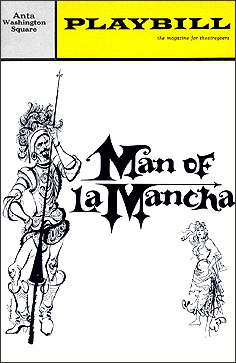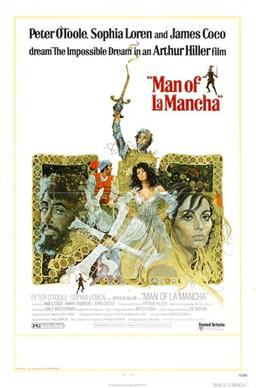
Don Quixote is a Spanish epic novel by Miguel de Cervantes. It was originally published in two parts, in 1605 and 1615. Considered a founding work of Western literature, it is often labelled as the first modern novel and the greatest work ever written. Don Quixote is also one of the most-translated books in the world and one of the best-selling novels of all time.

Miguel de Cervantes Saavedra was an Early Modern Spanish writer widely regarded as the greatest writer in the Spanish language and one of the world's pre-eminent novelists. He is best known for his novel Don Quixote, a work often cited as both the first modern novel and "the first great novel of world literature". A 2002 poll of 100 well-known authors voted it the "best book of all time", as voted by the judges from among the "best and most central works in world literature".

Man of La Mancha is a 1965 musical with a book by Dale Wasserman, music by Mitch Leigh, and lyrics by Joe Darion. It is adapted from Wasserman's non-musical 1959 teleplay I, Don Quixote, which was in turn inspired by Miguel de Cervantes and his 17th-century novel Don Quixote. It tells the story of the "mad" knight Don Quixote as a play within a play, performed by Cervantes and his fellow prisoners as he awaits a hearing with the Spanish Inquisition. The work is not and does not pretend to be a faithful rendition of either Cervantes' life or Don Quixote. Wasserman complained repeatedly about people taking the work as a musical version of Don Quixote.

La Mancha is a natural and historical region in the Spanish provinces of Albacete, Cuenca, Ciudad Real, and Toledo. It is an arid but fertile plateau that stretches from the mountains of Toledo to the western spurs of the Cuenca hills, bordered to the south by the Sierra Morena and to the north by Alcarria. The La Mancha historical comarca constitutes the southern portion of Castilla-La Mancha autonomous community and makes up most of the present-day administrative region.

Dulcinea del Toboso is a fictional character who is unseen in Miguel de Cervantes' novel Don Quixote. Don Quixote believes he must have a lady, under the mistaken view that chivalry requires it. As he does not have one, he invents her, making her the very model of female perfection: "[h]er name is Dulcinea, her country El Toboso, a village of La Mancha, her rank must be at least that of a princess, since she is my queen and lady, and her beauty superhuman, since all the impossible and fanciful attributes of beauty which the poets apply to their ladies are verified in her; for her hairs are gold, her forehead Elysian fields, her eyebrows rainbows, her eyes suns, her cheeks roses, her lips coral, her teeth pearls, her neck alabaster, her bosom marble, her hands ivory, her fairness snow, and what modesty conceals from sight such, I think and imagine, as rational reflection can only extol, not compare".

Monsignor Quixote is a novel by Graham Greene, published in 1982. The book is a pastiche of the classic 1605 and 1615 Spanish novel Don Quixote by Miguel de Cervantes with many moments of comedy, but also offers reflection on matters such as life after a dictatorship, Communism, and the Catholic faith.

Alonso Fernández de Avellaneda is the pseudonym of a man who wrote a sequel to Cervantes' Don Quixote, before Cervantes finished and published his own second volume.

Cide Hamete Benengeli is a fictional Arab Muslim historian created by Miguel de Cervantes in his novel Don Quixote, who Cervantes says is the true author of most of the work. This is a skilful metafictional literary pirouette that seems to give more credibility to the text, making the reader believe that Don Quixote was a real person and the story is decades old. However, it is obvious to the reader that such a thing is impossible, and that the pretense of Cide Hamete's work is meant as a joke.
I, Don Quixote is a non-musical play written for television and directed by Karl Genus. It was broadcast in season 3 of the CBS anthology series DuPont Show of the Month on the evening of November 9, 1959. Written by Dale Wasserman, the play was converted by him ca. 1964 into the libretto for the stage musical Man of La Mancha, with songs by Mitch Leigh and Joe Darion. After a tryout at Goodspeed Opera House in Connecticut, Man of La Mancha opened in New York on November 22, 1965, at the ANTA Washington Square Theatre.

Man of La Mancha is a 1972 film adaptation of the Broadway musical Man of La Mancha by Dale Wasserman, with music by Mitch Leigh and lyrics by Joe Darion. The musical was suggested by the classic novel Don Quixote by Miguel de Cervantes, but more directly based on Wasserman's 1959 non-musical television play I, Don Quixote, which combines a semi-fictional episode from the life of Cervantes with scenes from his novel.

Consuegra is a municipality located in the province of Toledo, Castile-La Mancha, Spain. In 2018, the municipality had a population of 10,098 inhabitants. It is 80 km from Ciudad Real and 60 km from Toledo. Consuegra is located in La Mancha region, famous for its extensive dry plains, vineyards and historical constructions such as windmills.
Don Quixote (1933) is a British-French film adaptation of the classic Miguel de Cervantes novel, directed by Georg Wilhelm Pabst, starring the famous operatic bass Feodor Chaliapin. Although the film stars Chaliapin, it is not an opera. However, he does sing four songs in it. It is the first sound film version of the Spanish classic. The supporting cast in the English version includes George Robey, René Donnio, Miles Mander, Lydia Sherwood, Renée Valliers, and Emily Fitzroy. The film was made in three versions—French, English, and German—with Chaliapin starring in all three versions.

Cayetano Hilario Abellán was a Spanish self-taught sculptor who produced sculptures based on different themes. His work is known because of his group of characters from the Miguel de Cervantes' well known novel Don Quixote, among others.

Donkey Xote is a 2007 3D computer-animated children's film produced by Lumiq Studios. A co-production between Spain and Italy, the film is directed by José Pozo and written by Angel Pariente, based on the Miguel de Cervantes novel Don Quixote, and features the voices of Andreu Buenafuente, David Fernández, Sonia Ferrer and José Luis Gil. The film has gained notoriety as a mockbuster as the lead character Rucio bears an intentional resemblance to Donkey from the Shrek film series, along with the poster having the tagline "From the producers who saw Shrek".
Don Quijote cabalga de nuevo is a 1973 Spanish-Mexican comedy film directed by Roberto Gavaldón, loosely based on Miguel de Cervantes's novel Don Quixote and starring Cantinflas as Sancho Panza, Fernando Fernán Gómez as Don Quixote, and María Fernanda D'Ocón as Dulcinea.
Gachupín is a Spanish-language term derived from a noble surname of northern Spain, the Cachopín of Laredo. It was popularized during the Spanish Golden Age as a stereotype and literary stock character representing the hidalgo class which was characterized as arrogant and overbearing. It may also be spelled cachopín, guachapín, chaupín or cachupino. The term remained popular in Mexico, where it would come to be used in the Cry of Dolores.

The Monument to Miguel de Cervantes is an instance of public art located in Madrid, Spain. Erected on the centre of the Plaza de España, it is dedicated to Miguel de Cervantes, widely regarded as the greatest writer in the Spanish language. The monument incorporates a stone monolith with several statues and a detached bronze sculptural group representing Don Quixote and Sancho Panza.

Don Quixote, Knight Errant is a 2002 Spanish adventure film directed and written by Manuel Gutiérrez Aragón, consisting of an adaptation of the second part of Miguel de Cervantes' Don Quixote. It stars Juan Luis Galiardo and Carlos Iglesias respectively as Don Quixote and Sancho Panza, alongside Santiago Ramos, Fernando Guillén Cuervo, Manuel Manquiña, Kiti Manver, Manuel Alexandre, Juan Diego Botto and Emma Suárez.


















